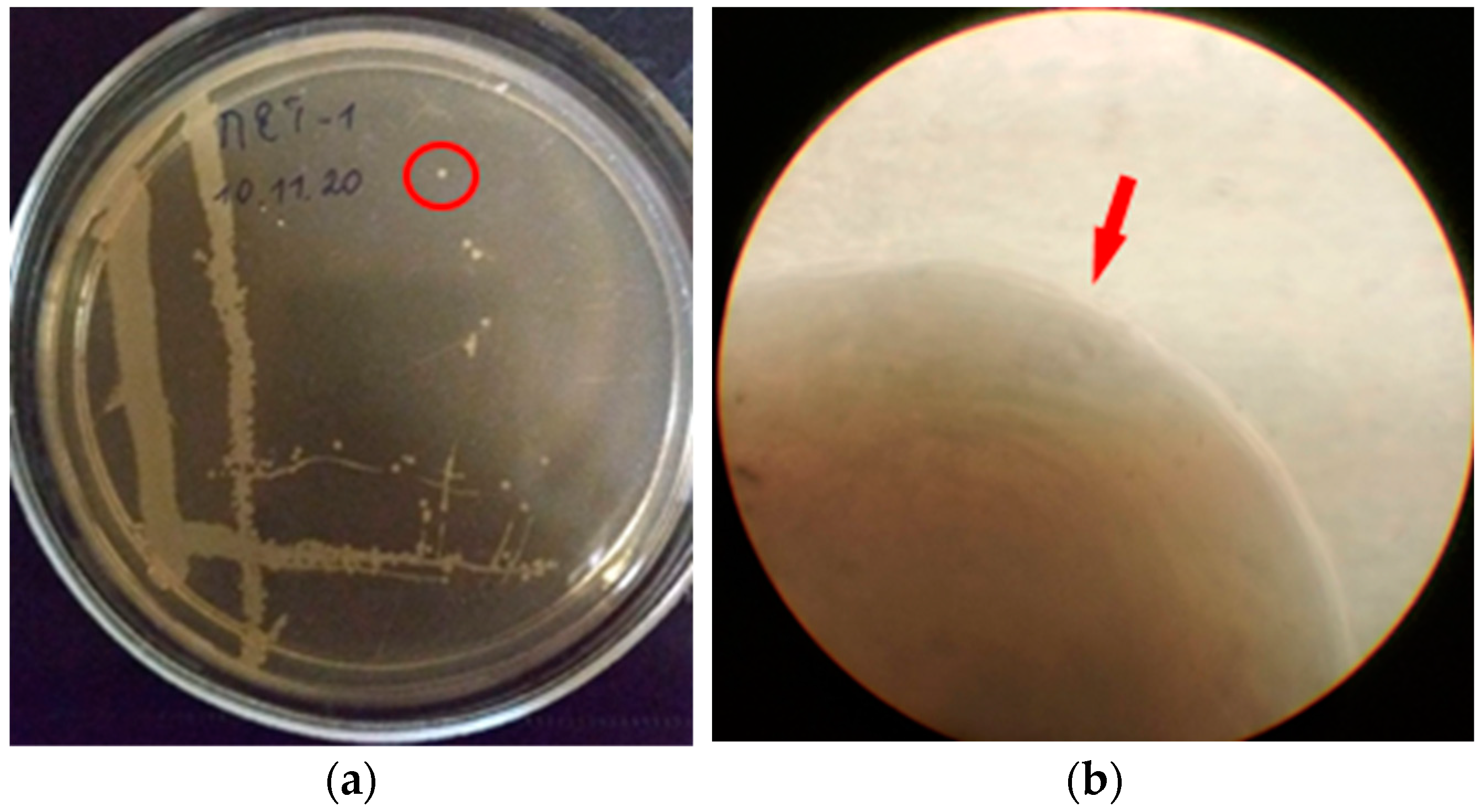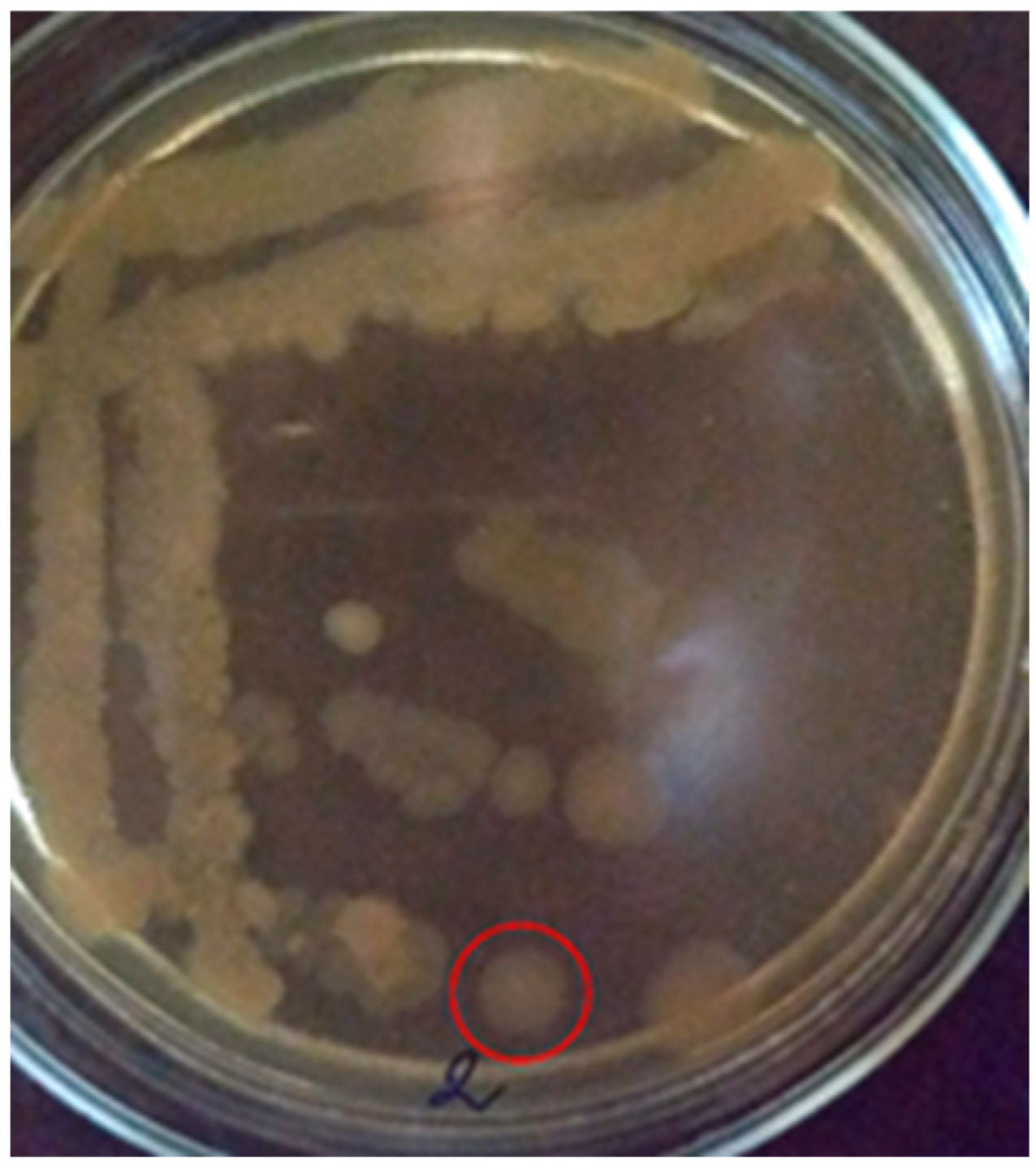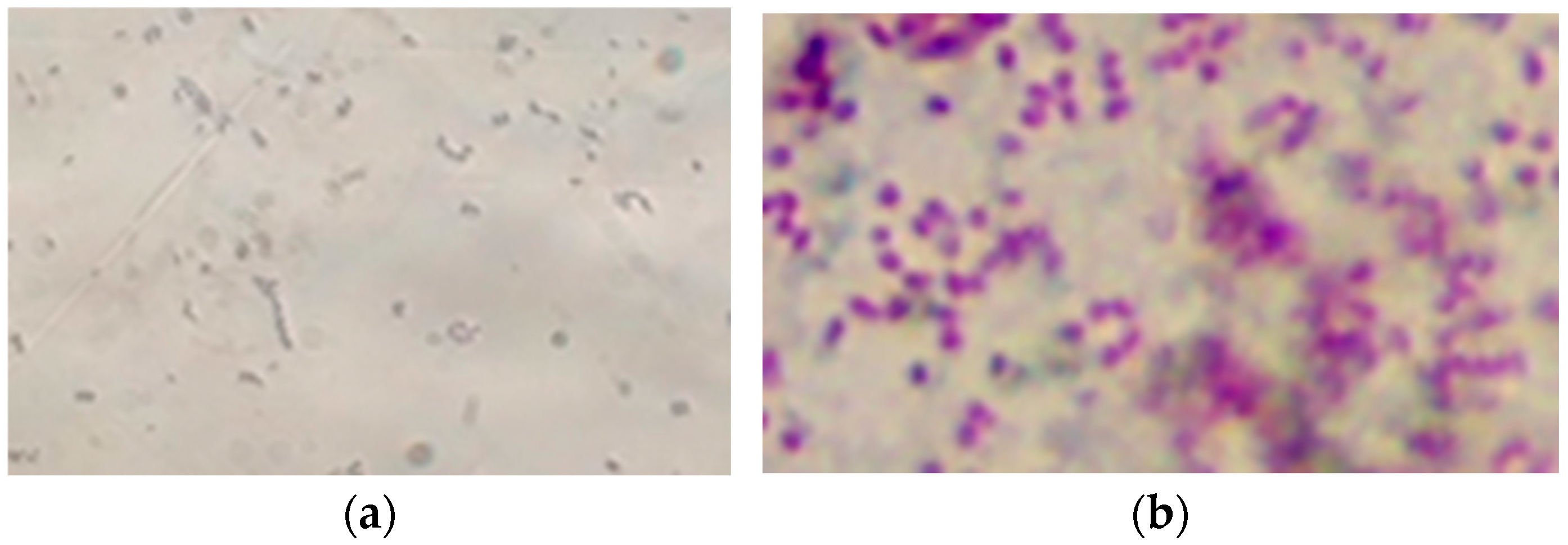Bacterial Strain from Biofilm on Surface of Poly(Ethylene Terephthalate) from Soil in Chernihiv City (Ukraine) Used as Potential Agent of Biodegradation †
Abstract
1. Introduction
2. Materials and Methods
2.1. Isolation of a Bacterial Isolate from a Biofilm Formed on the Surface of Poly(Ethylene Terephthalate)
2.2. Study of Cultural-Morphological and Some Physiological-Biochemical Properties of the Selected Isolate
2.3. Molecular Genetic Studies of the Selected Isolate
3. Results and Discussion
3.1. Microbiological Properties of PET1 and PET2 Isolates
3.2. Molecular and Genetic Properties of the PET1 Isolate
4. Conclusions
Author Contributions
Funding
Institutional Review Board Statement
Informed Consent Statement
Data Availability Statement
Conflicts of Interest
References
- Saveliev, Y.V.; Yanovich, I.V.; Akhranovych, O.R.; Markovska, L.A.; Veselov, V.Y. Creation and application of hydrocarbon-based polyurethanes that degrade under environmental conditions. Polymer. J. 2011, 33, 205–217. (In Ukrainian) [Google Scholar]
- Rogers, K.L.; Carreres-Calabuig, J.A.; Gorokhova, E.; Posth, N.R. Micro-by-micro interactions: How microorganisms influence the fate of marine microplastics. Limnol. Oceanogr. Lett. 2020, 5, 18–36. [Google Scholar] [CrossRef]
- Zhang, Y.; Ma, J.; Song, Y.-Q.; Li, G.; O’Connor, P. Stronger deterministic processes shape the plastisphere microbiota of biodegradable microplastics compared to non-biodegradable microplastics in farmland soil. Appl. Soil Ecol. 2024, 196, 105312. [Google Scholar] [CrossRef]
- Ya, H.; Xing, Y.; Zhang, T.; Lv, M.; Jiang, B. LDPE microplastics affect soil microbial community and form a unique plastisphere on microplastics. Appl. Soil Ecol. 2022, 180, 104623. [Google Scholar] [CrossRef]
- Liu, X.; Li, Y.; Yu, Y.; Yao, H. Effect of nonbiodegradable microplastics on soil respiration and enzyme activity: A meta-analysis. Appl. Soil Ecol. 2023, 184, 104770. [Google Scholar] [CrossRef]
- Andrushkiv, B.; Vovk, I.; Pogaidak, O. Improvement of the economic toolkit of finding new resources in the conditions of the post-Soviet society. Galician Econ. Herald. 2012, 3, 80–85. (In Ukrainian) [Google Scholar]
- Burak, O.M.; Kirichenko, A.Y. Creation of PET bottle collection points to improve the waste management process in Ukraine. In Proceedings of the International Science and Practice Internet Conference “Entrepreneurship and Business Administration”, Kharkiv, Ukraine, 10 February 2020. (In Ukrainian). [Google Scholar]
- Yoshida, S.; Hiraga, K.; Takehana, T.; Taniguchi, I.; Yamaji, H.; Maeda, Y.; Toyohara, K.; Miyamoto, K.; Kimura, Y.; Oda, K. A bacterium that degrades and assimilates poly(ethylene terephthalate). Science 2016, 351, 1196–1199. [Google Scholar] [CrossRef] [PubMed]
- Joo, S.; Cho, I.J.; Seo, H.; Son, H.F.; Sagong, H.Y.; Shin, T.J.; Choi, S.Y.; Lee, S.Y.; Kim, K.J. Structural insight into molecular mechanism of poly(ethylene terephthalate) degradation. Nat. Commun. 2018, 9, 382. [Google Scholar] [CrossRef]
- Chen, Z.; Wang, Y.; Cheng, Y.; Wang, X.; Tong, S.; Yang, H.; Wang, Z. Efficient biodegradation of highly crystallized polyethylene terephthalate through cell surface display of bacterial PETase. Sci. Total Environ. 2020, 709, 136138. [Google Scholar] [CrossRef]
- Vague, M.; Chan, G.; Roberts, C.; Swartz, N.A.; Mellies, J.L. Pseudomonas isolates degrade and form biofilms on polyethylene terephthalate (PET) plastic. bioRxiv 2019, 647321, 1–35. [Google Scholar] [CrossRef]
- Ru, J.; Huo, Y.; Yang, Y. Microbial Degradation and Valorization of Plastic Wastes. Front. Microbiol. 2020, 11, 442. [Google Scholar] [CrossRef] [PubMed]
- Chandramouli Swamy, T.M.; Nagarathna, S.V.; Reddy, P.V.; Nayak, A.S. Efficient biodegradation of Polyethylene terephthalate (PET) plastic by Gordonia sp. CN2K isolated from plastic contaminated environment. Ecotoxicol. Environ. Saf. 2024, 281, 116635. [Google Scholar] [CrossRef]
- Tkachuk, N.; Zelena, L. The Impact of Bacteria of the Genus Bacillus upon the Biodamage/Biodegradation of Some Metals and Extensively Used Petroleum-Based Plastics. Corros. Mater. Degrad. 2021, 2, 531–553. [Google Scholar] [CrossRef]
- Yan, Z.F.; Feng, C.Q.; Zhou, J.Q.; Huang, Q.S.; Chen, X.Q.; Xia, W.; Wu, J. Complete degradation of PET waste using a thermophilic microbe-enzyme system. Int. J. Biol. Macromol. 2024, 260 Pt 2, 129538. [Google Scholar] [CrossRef] [PubMed]
- Zeng, C.; Ding, F.; Zhou, J.; Dong, W.; Cui, Z.; Yan, X. Biodegradation of Poly(ethylene terephthalate) by Bacillus safensis YX8. Int. J. Mol. Sci. 2023, 24, 16434. [Google Scholar] [CrossRef]
- Kowalczyk, A.; Chyc, M.; Ryszka, P.; Latowski, D. Achromobacter xylosoxidans as a new microorganism strain colonizing high-density polyethylene as a key step to its biodegradation. Environ. Sci. Pollut. Res. 2016, 23, 11349–11356. [Google Scholar] [CrossRef]
- Tiwari, N.; Santhiya, D.; Sharma, J.G. Significance of landfill microbial communities in biodegradation of polyethylene and nylon 6,6 microplastics. J. Hazard Mater. 2024, 462, 132786. [Google Scholar] [CrossRef] [PubMed]
- Saeed, S.; Iqbal, A.; Deeba, F. Biodegradation study of Polyethylene and PVC using naturally occurring plastic degrading microbes. Arch. Microbiol. 2022, 204, 497. [Google Scholar] [CrossRef]
- Tkachuk, N.; Zelena, L.; Mazur, P.; Lukash, O. Genotypic, physiological and biochemical features of Desulfovibrio strains in a sulfidogenic microbial community isolated from the soil of ferrosphere. Ecol. Quest. 2020, 31, 79–88. [Google Scholar] [CrossRef]
- Tkachuk, N.; Zelena, L. Some corrosive bacteria isolated from the technogenic soil ecosystem in Chernihiv city (Ukraine). Stud. Quat. 2021, 38, 101–108. [Google Scholar] [CrossRef]
- Tkachuk, N.; Zelena, L. Bacterial sulfidogenic community from the surface of technogenic materials in vitro: Composition and biofilm formation. Biofouling 2023, 39, 327–338. [Google Scholar] [CrossRef]
- Tkachuk, N.; Zelena, L. Inhibition of heterotrophic bacterial biofilm in the soil ferrosphere by Streptomyces spp. and Bacillus velezensis. Biofouling 2022, 38, 916–925. [Google Scholar] [CrossRef]
- Tkachuk, N.; Zelena, L. The intensity of biofilm formation by heterotrophic bacteria isolated from soil ferrosphere. Ecol. Quest. 2023, 34, 37–41. [Google Scholar] [CrossRef]
- Tkachuk, N.; Zelena, L.; Mazur, P. Properties of anaerobic bacteria from ferrosphere crucial for biofilm development. Ecol. Quest. 2021, 32, 107–112. [Google Scholar]
- Tkachuk, N.; Zelena, L.; Lukash, O.; Mazur, P. Microbiological and genetic characteristics of Bacillus velezensis bacillibactin-producing strains and their effect on the sulfate-reducing bacteria biofilms on the poly(-ethylene terephthalate) surface. Ecol. Quest. 2021, 32, 119–129. [Google Scholar] [CrossRef]
- Postgate, J.R. The Sulfate-Reducing Bacteria; Cambridge University Press: Cambridge, UK, 1984; 224p. [Google Scholar]
- Furzikova, T.M.; Serhiychuk, M.G.; Vlasenko, V.V.; Shvets, Y.V.; Pozur, V.K. Microbiology. Practicum; Phytosocial Center: Kyiv, Ukraine, 2006; 210p. (In Ukrainian) [Google Scholar]
- Dikiy, I.L.; Holupyak, I.Y.; Sidorchuk, I.I. Microbiology. Laboratory Manual; Publishing house of NUPh “Zolotyie stranitsyi”: Harkov, Ukraine, 2002; 444p. (In Russian) [Google Scholar]
- Gerhardt, P. Methods for General and Molecular Bacteriology, 2nd ed.; Gerhardt, P., Murray, R.G.E., Krieg, N.R., Wood, W.A., Eds.; American Society for Microbiology: Washington, DC, USA, 1994; 791p. [Google Scholar]
- Lane, D.J. 16S/23S rRNA Sequencing. In Nucleic Acid Techniques in Bacterial Systematic; Stackebrandt, E., Goodfellow, M., Eds.; John Wiley and Sons: New York, NY, USA, 1991; pp. 115–175. [Google Scholar]
- Tamura, K.; Stecher, G.; Kumar, S. MEGA11: Molecular Evolutionary Genetics Analysis Version 11. Mol. Bio. Evol. 2021, 38, 3022–3027. [Google Scholar] [CrossRef]
- TRBA 466 “Einstufung von Prokaryonten (Bacteria und Archaea) in Risikogruppen”. Available online: https://www.baua.de/DE/Angebote/Rechtstexte-und-Technische-Regeln/Regelwerk/TRBA/pdf/TRBA-466.pdf?__blob=publicationFile&v=4 (accessed on 28 September 2024).
- Directive 2000/54/EC of the European Parliament and of the Council of 18 September 2000 on the Protection of Workers from Risks Related to Exposure to Biological Agents at Work, 2000. Official Journal of the European Communities. 17 October 2000, pp. 22–45. Available online: https://osha.europa.eu/en/legislation/directives/exposure-to-biological-agents/77 (accessed on 29 September 2024).
- Zlenko, V.V.; Piryatinska, N.E.; Lytvynenko, M.I.; Yavorska, O.M.; Denyshchuk, G.P.; Nechvoglod, T.O.; Slabodchykova, S.Y. (Eds.) Organization of Work and Provision of Sanitary and Anti-Epidemic Regime in Laboratory-Diagnostic Institutions of Various Profiles: Teaching. Manual; Under the editorship Zalyubovska, O.I.; KhNMU: Kharkiv, Ukraine, 2015; 56p, Available online: https://repo.knmu.edu.ua/server/api/core/bitstreams/49027a42-4e81-4cd7-b61b-7893a0b05abd/content (accessed on 29 September 2024). (In Ukrainian)
- Golubnycha, V.M.; Pogorelov, M.V.; Kornienko, V.V. Biosafety and Bioprotection in Biological Laboratories of the 1st and 2nd Levels of Biosafety: Monograph; Sumy State University: Sumy, Ukraine, 2016; 123p, Available online: https://core.ac.uk/download/pdf/141450992.pdf (accessed on 29 September 2024). (In Ukrainian)
- Pongchaikul, P. Comparative Genomic Approaches to Understanding Achromobacter xylosoxidans. Ph.D. Thesis, University of Liverpool, Liverpool, UK, September 2015. Available online: https://livrepository.liverpool.ac.uk/2050219/1/PongchaikulPis_Sep2015_2050219.pdf (accessed on 11 February 2024). [CrossRef]
- Padhi, S.K.; Maiti, N.K. Molecular insight into the dynamic central metabolic pathways of Achromobacter xylosoxidans CF-S36 during heterotrophic nitrogen removal processes. J. Biosci. Bioeng. 2017, 123, 46–55. [Google Scholar] [CrossRef] [PubMed]
- Strnad, H.; Ridl, J.; Paces, J.; Kolar, M.; Vlcek, C.; Paces, V. Complete genome sequence of the haloaromatic acid-degrading bacterium Achromobacter xylosoxidans A8. J. Bacteriol. 2011, 193, 791–792. [Google Scholar] [CrossRef] [PubMed]
- KEEG. Nitrogen Metabolism—Achromobacter xylosoxidans A8. Available online: https://www.genome.jp/kegg-bin/show_pathway?axy00910 (accessed on 11 February 2024).
- KEEG. Sulfur Metabolism—Achromobacter xylosoxidans A8. Available online: https://www.genome.jp/kegg-bin/show_pathway?axy00920 (accessed on 11 February 2024).
- KEEG. 2-Oxocarboxylic Acid Metabolism—Achromobacter xylosoxidans A8. Available online: https://www.kegg.jp/pathway/axy01210+AXYL_02631 (accessed on 11 February 2024).
- Basha, K.A.; Joseph, T.; Lalitha, K.V.; Vineetha, D.; Rathore, G.; Tripati, G.; Prasad, K. Nitrification Potential of Achromobacter xylosoxidans Isolated from Fresh Water Finfish Farms of Kerala, India. Int. J. Curr. Microbiol. App. Sci. 2018, 7, 2645–2654. [Google Scholar] [CrossRef]
- Jakobsen, T.H.; Hansen, M.A.; Jensen, P.Ø.; Hansen, L.; Riber, L.; Cockburn, A.; Kolpen, M.; Rønne Hansen, C.; Ridderberg, W.; Eickhardt, S.; et al. Complete genome sequence of the cystic fibrosis pathogen Achromobacter xylosoxidans NH44784-1996 complies with important pathogenic phenotypes. PLoS ONE 2013, 8, e68484. [Google Scholar] [CrossRef]
- Felgate, H.; Giannopoulos, G.; Sullivan, M.J.; Gates, A.J.; Clarke, T.A.; Baggs, E.; Rowley, G.; Richardson, D.J. The impact of copper, nitrate and carbon status on the emission of nitrous oxide by two species of bacteria with biochemically distinct denitrification pathways. Environ. Microbiol. 2012, 14, 1788–1800. [Google Scholar] [CrossRef] [PubMed]
- Liu, S.; Chen, Q.; Ma, T.; Wang, M.; Ni, J. Genomic insights into metabolic potentials of two simultaneous aerobic denitrification and phosphorus removal bacteria, Achromobacter sp. GAD3 and Agrobacterium sp. LAD9. FEMS Microbiol. Ecol. 2018, 94, fiy020. [Google Scholar] [CrossRef] [PubMed]
- Rad, M.M.; Moghimi, H.; Azin, E. Biodegradation of thermo-oxidative pretreated low-density polyethylene (LDPE) and polyvinyl chloride (PVC) microplastics by Achromobacter denitrificans Ebl13. Mar. Pollut. Bull. 2022, 181, 113830. [Google Scholar] [CrossRef]
- Nzila, A.; Ramirez, C.O.; Musa, M.M.; Sankara, S.; Basheer, C.; Li, Q.X. Pyrene biodegradation and proteomic analysis in Achromobacter xylosoxidans, PY4 strain. Int. Biodeter. Biodegrad. 2018, 130, 40–47. [Google Scholar] [CrossRef]
- Alassali, A.; Calmano, W.; Gidarakos, E.; Kuchta, K. The degree and source of plastic recycles contamination with polycyclic aromatic hydrocarbons. RSC Adv. 2020, 10, 44989. [Google Scholar] [CrossRef]
- Zhang, B.; Xu, W.; Ma, Y.; Gao, X.; Ming, H.; Jia, J. Effects of bioaugmentation by isolated Achromobacter xylosoxidans BP1 on PAHs degradation and microbial community in contaminated soil. J. Environ. Manag. 2023, 334, 117491. [Google Scholar] [CrossRef]
- Dey, A.S.; Bose, H.; Mohapatra, B.; Sar, P. Biodegradation of Unpretreated Low-Density Polyethylene (LDPE) by Stenotrophomonas sp. and Achromobacter sp., Isolated From Waste Dumpsite and Drilling Fluid. Front. Microbiol. 2020, 11, 603210. [Google Scholar] [CrossRef] [PubMed]
- Sui, B.; Wang, T.; Fang, J.; Hou, Z.; Shu, T.; Lu, Z.; Liu, F.; Zhu, Y. Recent advances in the biodegradation of polyethylene terephthalate with cutinase-like enzymes. Front. Microbiol. 2023, 14, 1265139. [Google Scholar] [CrossRef] [PubMed]
- Qiu, J.; Chen, Y.; Zhang, L.; Wu, J.; Zeng, X.; Shi, X.; Liu, L.; Chen, J. A comprehensive review on enzymatic biodegradation of polyethylene terephthalate. Environ. Res. 2024, 240 Pt 2, 117427. [Google Scholar] [CrossRef]
- Kushwaha, A.; Goswami, L.; Singhvi, M.; Kim, B.S. Biodegradation of poly(ethylene terephthalate): Mechanistic insights, advances, and future innovative strategies. Chem. Eng. J. 2023, 457, 141230. [Google Scholar] [CrossRef]





| Medium | Main Components, g/L of Distilled Water | Additional Components, g/L of Medium | References |
|---|---|---|---|
| A1 | KH2PO4—0.5 NH4Cl—1.0 Na2SO4—4.5 CaCl2 × 6H2O—0.06 MgSO4 × 7H2O—0.06 Sodium lactate—6 | Yeast extract—1.0 FeSO4 × 7H2O—0.5 5% NaHCO3 (to pH 7.5) Ascorbic acid—0.1 | [27] |
| B2 | KH2PO4—0.5 NH4Cl—1.0 Na2SO4—4.5 CaCl2 × 6H2O—0.06 MgSO4 × 7H2O—0.06 PET3 | FeSO4 × 7H2O—0.5 0.1 N NaOH (to pH 7.5) | this publication |
Disclaimer/Publisher’s Note: The statements, opinions and data contained in all publications are solely those of the individual author(s) and contributor(s) and not of MDPI and/or the editor(s). MDPI and/or the editor(s) disclaim responsibility for any injury to people or property resulting from any ideas, methods, instructions or products referred to in the content. |
© 2025 by the authors. Licensee MDPI, Basel, Switzerland. This article is an open access article distributed under the terms and conditions of the Creative Commons Attribution (CC BY) license (https://creativecommons.org/licenses/by/4.0/).
Share and Cite
Tkachuk, N.; Zelena, L. Bacterial Strain from Biofilm on Surface of Poly(Ethylene Terephthalate) from Soil in Chernihiv City (Ukraine) Used as Potential Agent of Biodegradation. Biol. Life Sci. Forum 2024, 39, 2. https://doi.org/10.3390/blsf2024039002
Tkachuk N, Zelena L. Bacterial Strain from Biofilm on Surface of Poly(Ethylene Terephthalate) from Soil in Chernihiv City (Ukraine) Used as Potential Agent of Biodegradation. Biology and Life Sciences Forum. 2024; 39(1):2. https://doi.org/10.3390/blsf2024039002
Chicago/Turabian StyleTkachuk, Nataliia, and Liubov Zelena. 2024. "Bacterial Strain from Biofilm on Surface of Poly(Ethylene Terephthalate) from Soil in Chernihiv City (Ukraine) Used as Potential Agent of Biodegradation" Biology and Life Sciences Forum 39, no. 1: 2. https://doi.org/10.3390/blsf2024039002
APA StyleTkachuk, N., & Zelena, L. (2024). Bacterial Strain from Biofilm on Surface of Poly(Ethylene Terephthalate) from Soil in Chernihiv City (Ukraine) Used as Potential Agent of Biodegradation. Biology and Life Sciences Forum, 39(1), 2. https://doi.org/10.3390/blsf2024039002






